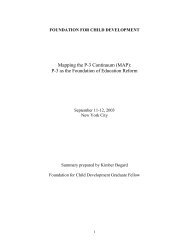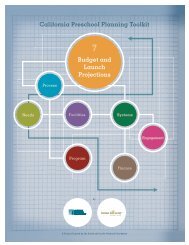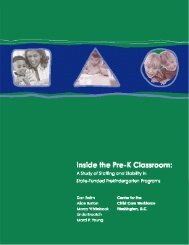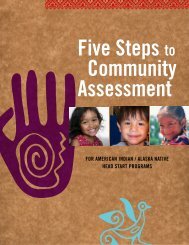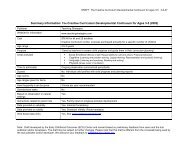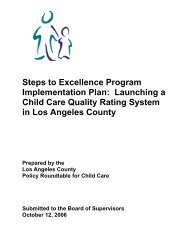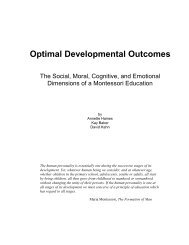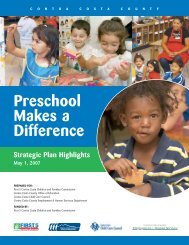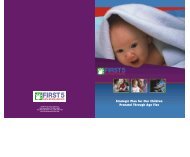Download this file - Plan4Preschool
Download this file - Plan4Preschool
Download this file - Plan4Preschool
You also want an ePaper? Increase the reach of your titles
YUMPU automatically turns print PDFs into web optimized ePapers that Google loves.
Strategic Plan<br />
DRAFT<br />
2007-2010
Table of Contents<br />
3<br />
5<br />
6<br />
7<br />
13<br />
17<br />
19<br />
20<br />
23<br />
24<br />
Introduction<br />
Background<br />
Guiding Principles<br />
Community Pro<strong>file</strong><br />
Goals and Objectives<br />
Current Funded Programs<br />
Budget<br />
Evaluation Design<br />
Financial Accountability Framework<br />
End Notes
The Sutter County Children and<br />
Families Commission<br />
Nancy Aaberg Superintendent Yuba Sutter Unified<br />
School District<br />
Brian Aronson Judge Sutter County<br />
Consolidated Court<br />
Richard Doscher Chief Yuba City Police<br />
Department<br />
Olga Gonzalez MD Sutter County Health<br />
Department<br />
Lori Harrah Assistant Director-<br />
Social Services<br />
Sutter County Human<br />
Services Department<br />
Joan Hoss Assistant Director-<br />
Mental Health Services<br />
Sutter County Human<br />
Services Department<br />
Christine Odom Chief Probation Officer Sutter County Probation<br />
Department<br />
Jim Whiteaker Member Sutter County Board of<br />
Supervisors<br />
Edmund Smith Director Sutter County Human<br />
Services Department<br />
Many Thanks to Our Participants<br />
Gurmeet Chahal Maria C. Romero Gaileen Bumgarner<br />
Iqbal Kaur Delfina Alvarado Lynne Gilbert<br />
Jaswant Kaur Martha Oregel Ymelda Mendoza<br />
Indera Tumber Maria Pedroza Moises Kris Welch<br />
Satinder Baims Isabel Madrigal Angela Dahlsrud<br />
Thelma Anaya Erica Melcher Tresia Filby<br />
Jorgine Rogers Claudia Salcido Mil Elliott<br />
Dave Morrow Doreen Osumi Mary Chin<br />
Mary Rice Eva Teagarden Karen Crawford<br />
Bill Zeller Lavena Williams Tim Moriarty<br />
Elizabeth Engelken<br />
Cindy Chandler<br />
Staff and Support<br />
Deb Coulter, Executive<br />
Director<br />
Bev Dal Porto, Executive<br />
Secretary<br />
Brad Morrison, Strategic<br />
Planning Consultant,<br />
Morrison Forbes
INTRODUCTION<br />
Significant research has shown that the emotional,<br />
physical, and intellectual world a child<br />
experiences during the first five years will<br />
critically influence his or her lifelong<br />
development.<br />
In order to address those extremely important first<br />
five years of life, Sutter County invests over 1.1<br />
million dollars per year into programs and<br />
services for young children and their families.<br />
In 2005-06, an unduplicated total of 1,910<br />
children, ages 0-5, received services from one or<br />
more SCCFC-funded programs, an increase of<br />
340 children (18%) over 2004-05.<br />
Improved Family Functioning<br />
The Child Development Behavioral Initiative<br />
(CDBI) served 91 children with behavior<br />
problems in fiscal year 2005-06. Of those 91, 93%<br />
completed at least a portion of their treatment plan<br />
goals, with demonstrated improvements in<br />
children’s behavior. In addition, CDBI provided<br />
12 parent workshops attended by 310 parents.<br />
Family SOUP provided case management services<br />
to 68 families and additional services to another<br />
44 families of children with disabilities and other<br />
special needs. Parents reported a greater<br />
understanding of their children’s needs, more<br />
confidence, and less stress.<br />
Improved Child Development<br />
The Smart Start pre kindergarten program taught<br />
basic school readiness skills to 181 children with<br />
limited or no pre school experience at seven<br />
school sites. Pre to post preschool assessments for<br />
Smart Start program participants revealed<br />
statistically significant improvement in all areas<br />
that were tested. In addition, 63% of Smart Start<br />
children’s parents attended parent workshops.<br />
The School Readiness Program (SR) directly<br />
served 709 children, 629 parents and offered<br />
developmentally appropriate learning activities to<br />
strengthen children’s early literacy skills in fiscal<br />
year 2005-06. In addition, SR coordinators<br />
distributed 792 Kindergarten and pre kindergarten<br />
backpacks and provided 218 referrals and<br />
assistance efforts to 122 families.<br />
Healthy Children and Families<br />
Sutter County Smiles, mobile dental clinic<br />
provided dental screenings, cleanings or<br />
restorative treatments to 700 children. Of those,<br />
61% of their parents stated that their child would<br />
not have received dental care <strong>this</strong> year without the<br />
dental van.<br />
The Bright Futures Program provided health and<br />
developmental screenings to 400 children in fiscal<br />
year 2005-06 and facilitated 360 referrals for 249<br />
children.<br />
The Initiative on Child Health Immunizations<br />
provided 2,330 free immunizations to 633<br />
children. Of those children, 41% had no insurance<br />
at the time of service. Eleven percent of parents<br />
reported that immunizations would not have been<br />
possible without the free program.<br />
Improved Systems of Care<br />
Sutter County has made a continuing investment<br />
into the evaluation of its programs and services.<br />
This year the Commission established a database<br />
to track the number of interactions between its<br />
grantee agencies. They also use the database to<br />
track outcomes for children served.<br />
All programs showed an increased level of crossprogram<br />
interaction from the 2004-05 program<br />
cycle, indicating a high level of interaction has<br />
been achieved. The data showed that 47 percent of<br />
the children served attended two or more<br />
Commission funded programs, compared to only<br />
36 percent in 2004-05, an improvement of nearly<br />
one-third. These data indicate that the<br />
Commission is having success in getting more<br />
intensive services to a greater number of children.<br />
The 2005-06 program cycle data also indicated<br />
that greater SCCFC-program contact leads to<br />
better kindergarten readiness.
BACKGROUND<br />
In November of 1998, California voters<br />
approved Proposition 10, a constitutional<br />
amendment that dedicated a portion of taxes<br />
on tobacco products to the development of<br />
the California Children and Families<br />
Initiative.<br />
The California Legislature followed the<br />
direction of the Proposition and enacted the<br />
Children and Families Act, which authorized<br />
counties in California to create local<br />
commissions to administer funds derived<br />
from the tax on tobacco products. County<br />
Commissions receive revenues generated by<br />
the tax based upon the annual recorded<br />
births to county residents.<br />
According to the Act, each California<br />
County Board of Supervisors must appoint a<br />
Children and Families First Commission to<br />
oversee planning and distribution of the<br />
Proposition 10 fund in its county.<br />
Sutter County, acting through its Board of<br />
Supervisors, approved an ordinance<br />
establishing the Sutter County Children and<br />
Families Commission, appointed<br />
commissioners, and established the Sutter<br />
County Children and Families Commission<br />
Trust Fund on January 5, 1999.<br />
The California Children and Families<br />
Initiative (Proposition 10) is based on<br />
research stressing the importance of early<br />
physical, emotional and intellectual<br />
nurturing as the foundation for later<br />
development. Investing in our children<br />
during their earliest years, by providing their<br />
parents and caregivers the tools necessary to<br />
foster healthy, loving relationships, will not<br />
only prepare these children for academic<br />
success, it will positively impact the quality<br />
of their later lives. To <strong>this</strong> end, the Act<br />
identifies three focus areas for<br />
implementation:<br />
• Parent Education and Support Services<br />
• Childcare and Early Childhood<br />
Development<br />
• Health and Wellness<br />
The California Children and Families<br />
Commission considers the following<br />
dimensions of child development to be<br />
important:<br />
• Physical development: Meeting<br />
children’s basic needs for protection,<br />
nutrition and health care.<br />
• Cognitive and social-emotional<br />
development: Meeting children’s basic<br />
human needs for affection, security,<br />
social participation and interaction with<br />
others, as well as educational needs<br />
through intellectual stimulation,<br />
exploration, imitation, trial and error,<br />
discovery, and active involvement in<br />
learning and experimentation within a<br />
safe and stimulating environment.<br />
Proposition 10 funds are to be used<br />
exclusively to promote, support, and<br />
improve the early development, of children<br />
from the prenatal stage through age five,<br />
through a comprehensive and integrated<br />
delivery system of information and services.<br />
Each County Commission must develop a<br />
comprehensive strategic plan that outlines<br />
how the Commission will utilize the<br />
revenues generated by the tax. Health and<br />
Safety Code Section 130140 (1)(C)(ii) of the<br />
Act Requires County Commission strategic<br />
plans to include, at a minimum, the<br />
following components:<br />
• A description of the goals and<br />
measurable objectives to be attained;<br />
• A description of the programs of the<br />
programs, services and projects to be<br />
provided, sponsored or facilitated;<br />
• A description of how measurable<br />
outcomes of such programs, services<br />
and projects will be determined by the<br />
County Commission using appropriate<br />
reliable indicators; and<br />
• A description of how programs,<br />
services, and projects relating to early<br />
childhood development within the<br />
county will be integrated into a<br />
consumer-oriented and easily accessible<br />
system.
GUIDING PRINCIPLES<br />
In adopting <strong>this</strong> comprehensive strategic plan, the Sutter County Children and Families<br />
Commission identified seven basic principles to govern the planning activities and to provide<br />
guidance on the future allocation of funds and program development.<br />
1. Services should be designed to serve all children and families eligible under the<br />
guidelines of Proposition 10 of Sutter County who wish to benefit from the proposed<br />
services.<br />
2. Proposed services should not duplicate existing community services.<br />
3. Proposed services should provide for the maximum amount of integration possible<br />
between existing community programs and newly established programs.<br />
4. Proposed services should focus on service delivery at the earliest possible point of<br />
intervention.<br />
5. Proposed services should provide a significant impact on the lives of children and<br />
families served.<br />
6. Proposed services should contain measurable outcomes of all services provided for<br />
the purpose of evaluation.
COMMUNITY PROFILE<br />
The Sutter County Children and Families<br />
Commission embraced a three-level<br />
approach to organize the data in <strong>this</strong> report,<br />
soliciting and collecting information from<br />
multiple sources in order to develop a<br />
comprehensive understanding of the<br />
conditions for children and families within<br />
the county.<br />
The Community Needs Assessment Data was<br />
drawn from various data sources including<br />
the U. S. Census, California Department of<br />
Finance, California Department of Health<br />
and other large public data systems. The<br />
Community and Professional Survey Data<br />
was developed from a survey questionnaire<br />
distributed to community members and<br />
professionals throughout the county. The<br />
Commission distributed over 1,000 surveys<br />
and received over 190 responses.<br />
Additionally, they advertised the survey in<br />
the local paper and provided access to a<br />
web-based survey response form. The Focus<br />
Group information is the result of specific<br />
outreach to non-English speaking parents<br />
and community members in addition to<br />
groups of educators and children’s service<br />
providers. Sutter County conducted six<br />
focus groups and engaged 42 people in <strong>this</strong><br />
process.<br />
Community Needs Assessment Data<br />
Demographics<br />
Sutter County is situated in the northern<br />
Sacramento valley, covering 602.7 square<br />
miles of farmlands and completely<br />
encompassing the Sutter Buttes mountain<br />
range. With a population density of 147.6<br />
residents per square mile Sutter County is<br />
considered a rural county, well below the<br />
average California population density of<br />
235.6 residents per square mile. i<br />
Sutter County has 88,945 residents. Between<br />
2000 and 2005, Sutter County grew steadily,<br />
increasing its total population by 11.5%. The<br />
area has one urban center in Yuba City, the<br />
county seat, which is home to 58,368<br />
people, 66% of the county population.<br />
Outside of the incorporated City of Live<br />
Oak, with a population of 6,785, the<br />
county’s residents live in small communities<br />
and unincorporated areas. ii There are an<br />
estimated 7,533 children in the county,<br />
ranging from birth through age 5. iii<br />
Population Growth In Sutter County<br />
Year<br />
Sutter<br />
2000 78,700<br />
2005 88,945<br />
5 Year Growth, 2000-2005 11.5%<br />
Source: Cal. Dept. of Finance<br />
Sutter County has seen increases across all<br />
of its largest ethnic sub-populations since<br />
the year 2000. Of all the ethnic groups<br />
reported, people of Hispanic (22.9%) and<br />
Asian (19.8%) descent experienced the<br />
largest population growth. iv<br />
Sutter County Population by Ethnicity: Changes Over 5 years<br />
Total<br />
White Hispanic Asian Black Amer. Indian<br />
2000 79,464 47,688 17,483 9,694 1,467 1,011<br />
2005 88,297 48,050 22,665 12,080 1,861 1,649<br />
Increase 10% .75% 22.9% 19.8% 21.2% 38.7%<br />
Source: Cal. Dept. of Finance<br />
Family Economics<br />
The estimated median household income of<br />
Sutter residents was 39,633 per family in<br />
2003, which lagged behind the statewide<br />
average median income of 48,440.<br />
Household income is an important measure<br />
of community prosperity. Per capita income,<br />
also an indicator of financial health was<br />
25,606 per person in 2003. Both of these<br />
numbers have historically paralleled the<br />
growth in statewide and regional averages. v<br />
Median Household Income, 2003<br />
Sutter 39,633<br />
California 48,440<br />
Source: U. S. Department of Commerce, Bureau of the<br />
Census
In 2003, 12.9% of the total Sutter County<br />
population lived below the poverty rate. The<br />
2003 rate is comparable to the California<br />
average of 13.8%. Both the state and Sutter<br />
County experienced declines in the rates of<br />
poverty over five years between 1999 and<br />
2003. vi In 2002, 18.2% of Sutter County<br />
children, ages 0-5, lived below the poverty<br />
rate. This number has gradually improved<br />
over the years. During 2002, the statewide<br />
average was 19.8%. vii Another strong<br />
influence on the poverty threshold is the<br />
relative cost of housing. The cost of renting<br />
a home in Sutter County actually increased<br />
by 23.9% between the years 2000 and 2005.<br />
The Fair Market Rent is now 854 dollars per<br />
month. viii Persons Below Poverty<br />
1999 2003<br />
Sutter 15.5% 12.9%<br />
California 14.2% 13.8%<br />
Source: U. S. Census, 2000/ Economic Projections<br />
Less than 2% of all Sutter County<br />
households rely on Food Stamps to<br />
supplement the family budget. ix Although<br />
<strong>this</strong> number fluctuates annually, since 1997,<br />
the overall number has declined in Sutter<br />
County while increasing at the state and<br />
national levels.<br />
Family Health<br />
The infant mortality rate of 3.4 in Sutter<br />
County is below the statewide average of 5.2<br />
and the national standard of 4.5 set by<br />
United States Department of Health and<br />
Human Services, Healthy People 2010<br />
Goals. x<br />
Infant Mortality Rate<br />
Sutter, 2003 3.4<br />
California, 2003 5.2<br />
Healthy People 2010 4.5<br />
Source: Sutter County Health Dept., Maternal Child Health<br />
Report, 2004; Children Now, 2005; Healthy People 2010<br />
In 2003, 10.4% of all births in the county<br />
were from teenage mothers. This is<br />
comparable to the California average of<br />
9.1%. The average number births to teen<br />
mothers less than age 15 was .06%, also<br />
comparable to the state average for that age<br />
group. xi<br />
The low numbers (66%) of women<br />
accessing prenatal care in the first trimester<br />
continues to be a concern in Sutter County.<br />
A number of factors including cultural<br />
traditions, transportation and language<br />
barriers play a part in the relatively high<br />
percentages of women receiving no prenatal<br />
care. The rates are unusually low in<br />
comparison with state (87%) and Healthy<br />
People 2010 standards (90%). xii<br />
Prenatal Care During First Trimester<br />
Sutter, 2003 66%<br />
California 87%<br />
Healthy People 2010 90%<br />
Source: Sutter County Health Dept., Maternal Child Health<br />
Report, 2004; Children Now, 2005; Healthy People 2010<br />
According to data from a regional study<br />
conducted in 2004 about 13% of households<br />
in Sutter County do not have health<br />
insurance. xiii<br />
Another key area of well being for children<br />
is the low birth-weight rate. It is a very<br />
important measure of risk factors for infant<br />
health. Sutter County’s rate (6.0%) is<br />
favorable, located in the top third of the<br />
state’s counties. xiv<br />
Low Birth Weight Infants (3 Year<br />
Average)<br />
Sutter, 2003 6.0%<br />
California, 2003 6.6%<br />
Healthy People 2010 5<br />
Source: Sutter County Health Dept., Maternal Child Health<br />
Report, 2004; Children Now, 2005; Healthy People 2010<br />
Approximately 20% of the total Sutter<br />
County population currently lives with a<br />
disability, which is comparable with state<br />
and national averages. Generally, the<br />
proportion of children with disabilities is
much lower than that of the total population,<br />
as the rate increases with age. Sutter County<br />
with 5.8% of children, ages 5-15 living with<br />
a disability is higher than the statewide<br />
average of 4.8% children in the same age<br />
group.<br />
Early Care and Development<br />
Comparatively, the average cost of fulltime,<br />
licensed childcare is significantly lower than<br />
other areas in California, although it still<br />
represents a significant percentage of total<br />
family income. Across the different agegroups<br />
(under 2 and 2-5) of the children and<br />
the type of care (Family Care or Centerbased)<br />
the cost of fulltime licensed childcare<br />
within Sutter County is 30% to 45% less<br />
expensive than the statewide average. xv<br />
In Sutter County, there are gaps in the<br />
availability of affordable, quality childcare.<br />
According to a 2005 data report, there were<br />
36 Center-based programs and 112 Family<br />
Care Centers, which was only enough<br />
licensed childcare for 30% of the children of<br />
parents in the labor force. xvi This gap<br />
combined with the large numbers of<br />
households with working parents creates a<br />
situation where many of the families rely on<br />
other family members, including siblings<br />
and elders, regardless of their ability to<br />
provide for the children in their care.<br />
In 2000, slightly less than half (47.8%) of all<br />
children were enrolled in preschool<br />
compared the state average of 56.6% of all<br />
children. xvii<br />
Approximately 30% of all Sutter County<br />
households speak a language other than<br />
English in the home. xviii Across all three of<br />
the schools in the School Readiness<br />
Program, the participants averaged 46%<br />
English Language Learners and 90%<br />
enrollment in Chapter 1, free and reduced<br />
lunch programs. The primary languages<br />
spoken at home were Spanish, English and<br />
Punjabi. xix<br />
Community and Professional Survey<br />
Results<br />
The Sutter County Children and Families<br />
Commission surveyed community and childserving<br />
professionals in order to assess the<br />
unmet needs of children. The Commission<br />
received 190 responses. The aggregated data<br />
is presented in the following table.<br />
4.60<br />
4.40<br />
4.204.12<br />
4.00<br />
3.80<br />
3.60<br />
3.40<br />
3.72<br />
Community And Professional Survey<br />
4.434.44<br />
4.27<br />
4.14<br />
4.014.00<br />
3.91<br />
4.26 4.32 3.79<br />
4.05 4.12<br />
3.20<br />
1 2 3 4 5 6 7 8 9 10 11 12 13 14<br />
Preference<br />
Community Survey Preferences Key<br />
(Refer to Survey Chart Above)<br />
1 Free Children’s<br />
Books<br />
8 Medi-Cal<br />
Assistance<br />
2 Literacy<br />
Backpacks<br />
9 Web Listing of<br />
Childcare<br />
3 Literacy Classes 10 Free Classes<br />
(Nutrition,<br />
Obesity, Activity)<br />
4 Improved Parent<br />
–Teacher<br />
11 Parent Skill<br />
Classes<br />
Communication<br />
5 Summer 12 Arts Activities<br />
Kindergarten<br />
6 Pregnancy/Pren 13 Library And<br />
atal Classes<br />
7 Breastfeeding<br />
Info<br />
Storytelling<br />
14 Safety Info<br />
When all the surveys were combined, the<br />
top five community needs were; parent and<br />
teacher communications, child literacy,<br />
parent skill classes, summer prekindergarten<br />
and free classes for parents<br />
(nutrition, obesity, activity).
4.5<br />
4.45<br />
4.4<br />
4.35<br />
4.3<br />
4.25<br />
4.2<br />
4.15<br />
4.44 4.43<br />
Top 5 Survey Preferences<br />
4.32<br />
Improved Parent Literacy ClassesParent Skill<br />
Teacher<br />
Classes<br />
Communication<br />
Preference<br />
Community Focus Group Themes<br />
4.27 4.26<br />
Summer Pre- Free Classes<br />
Kindergarten (Nutrition,<br />
Activity)<br />
The Commission held six focus groups<br />
organized in conjunction with its School<br />
Readiness re-application process. From<br />
these focus groups, several common themes<br />
emerged as people spoke about the issues<br />
facing children and families in the county.<br />
Parent Education<br />
The most common theme expressed in all of<br />
the groups was the need to address parent<br />
education. There were many variations of<br />
<strong>this</strong> one theme but overall, the direction was<br />
very clear. The following topics were<br />
variations upon that theme.<br />
• Nutrition: The need to address poor diet<br />
habits, increasing dental problems<br />
among young children and childhood<br />
obesity all pointed towards the area of<br />
nutrition education for parents and care<br />
providers. Many were concerned about<br />
young children being given soda and<br />
sugary juices in baby bottles.<br />
Focus Group Theme:<br />
Parent Education<br />
Nutrition<br />
Child Development<br />
Skill Development<br />
Low Literacy Among Parents<br />
Positive Discipline<br />
Family Communication<br />
• Child Development: There was also<br />
significant interest in the area of child<br />
development. Parents and service<br />
providers thought there should be more<br />
information and resources out in the<br />
community about normal child<br />
development patterns and advice and<br />
techniques for parents to know more<br />
about their child’s needs at any given<br />
period in the development process.<br />
• Improved Parenting Skills: There were<br />
multiple suggestions for skill<br />
development including appropriate<br />
discipline, taking instruction from<br />
adults, recognizing authority figures,<br />
becoming more involved with the<br />
child’s school, learning how to involve<br />
fathers in raising children and learning<br />
how to read to the children and guidance<br />
about appropriate decisions around<br />
television and video games. There were<br />
also suggestions about providing parents<br />
more opportunities to network together.<br />
In general there was recognition that <strong>this</strong><br />
is a generational problem in that many<br />
parents have not been taught the basics<br />
of child rearing nor have they had good<br />
role models.<br />
• Skill development: The need to help<br />
children develop more cognitive and<br />
language skills was an emphasis in<br />
many of the focus groups. Many parents<br />
were interested in having their children<br />
learn more of these basics prior to<br />
attending preschool.<br />
• Low Literacy Levels Among Parents:<br />
The level of literacy among some of the<br />
parents was a concern, particularly for<br />
the educators and service providers. A<br />
small percentage of the parents are not<br />
literate in their native languages. This<br />
creates a challenge when it comes to<br />
preparing your children for school,<br />
reading important information from the<br />
school and developing fluency in<br />
English.<br />
• Positive Discipline: There were<br />
concerns expressed both by parents,<br />
educators and service providers about<br />
the need to provide some instruction on<br />
parenting techniques to learn more<br />
appropriate and effective ways to<br />
discipline their children.
• Family Communications: The<br />
participants noted a general decline in<br />
the quality of communication in<br />
families.<br />
Language: As part of the effort to include<br />
community members in the data collection<br />
process, three focus groups were conducted<br />
in alternate languages; Spanish (2) and<br />
Punjabi (1). The topics of language and<br />
language gaps were universally addressed in<br />
all of the focus groups.<br />
Focus Group Theme:<br />
Language<br />
Awareness and Understanding<br />
Willingness to Learn<br />
Learning Delays<br />
• Awareness and Understanding: In<br />
particular, there was a general need cited<br />
that parents need to know “what is going<br />
on”. Some made mention of the fact that<br />
many parents who did not read English<br />
often had to find a friend to interpret the<br />
(daily to weekly) messages from school.<br />
Many of the parents expressed their<br />
appreciation for the efforts to provide<br />
native-language translation for the<br />
important documents or the provision of<br />
bi-lingual staffing. They also indicated<br />
that bi-lingual staff made them feel<br />
more comfortable and more welcomed.<br />
• Willingness to Learn: Many of the<br />
parents expressed their willingness to<br />
have their children learn English. Many<br />
parents also indicated a willingness to<br />
learn as well, especially when it came to<br />
the safety and well-being of their<br />
children.<br />
• Learning Delays: The educators and<br />
service providers articulated the need for<br />
additional work to offset the limits of<br />
parents who may not speak English or<br />
may have additional literacy challenges<br />
as these factors can slow the<br />
development of young children and<br />
delay their readiness for school.<br />
General Issues for Families:<br />
There were several themes that did not rise<br />
to the level of a category but stood out as<br />
significant topics.<br />
• Navigating the System was a common<br />
theme in all of the focus groups. There<br />
were general concerns about the ability<br />
of people to get services and resources<br />
and know how to effectively access the<br />
resources available for their children.<br />
Making connections with the school<br />
personnel and other parents were also<br />
key strategies that parents use to keep up<br />
with current information.<br />
Focus Group Theme:<br />
General Issues for Families<br />
Navigating the System<br />
Childcare Issues<br />
Behavioral Issues<br />
Transportation and Access<br />
Safety and Security<br />
Media Influence<br />
Workplace Issues<br />
• Childcare Issues: The data indicates that<br />
many parents are now working parents.<br />
These individuals and families, now<br />
absent from their homes, have to make<br />
arrangements for the care of their<br />
children to the best of their ability. The<br />
quality of that care was the major<br />
concern in many of the focus groups.<br />
The participants in the childcare group<br />
suggested a variety of interventions to<br />
provide information and training on<br />
child development, particularly<br />
addressing “mediocre” providers. As far<br />
as family care, there were additional<br />
concerns expressed (in all of the groups)<br />
that the people providing the care for the<br />
young children needed to get the<br />
information directly, including<br />
grandparents, aunts and siblings. One<br />
example given was that many elders use<br />
the television to calm the children down.<br />
• Behavioral Issues: There were two<br />
themes concerning the behaviors of
children. One theme addressed the need<br />
for additional interventions (beyond the<br />
current level of CDBI service). The<br />
other theme suggested that a big part of<br />
the problem stemmed from the lack of<br />
parenting skills to effectively address<br />
those behaviors at home.<br />
• Transportation and access to services<br />
for people in the outlying communities<br />
and even within the Yuba City limits<br />
were issues that were universally<br />
recognized across the groups but there<br />
were no follow-up suggestions for<br />
improvement.<br />
• Safety and security were also on the<br />
minds on several of the participants as<br />
they expressed concerns for their<br />
children to be safe in their own<br />
neighborhoods.<br />
• Media Influence: There was also some<br />
concern around the passive nature of<br />
children’s entertainment particularly<br />
television and video games and that<br />
these diversions do little to stimulate<br />
imagination and physical activity.<br />
• Workplace Issues: There were also<br />
suggestions to contact and provide<br />
information to employers to make<br />
workplaces more family-friendly.
GOALS AND OBJECTIVES<br />
Goal<br />
Improved Family Functioning<br />
Through education, information and support services, all Sutter County families will have<br />
opportunities to learn parenting practices that promote safe, nurturing and understanding<br />
environments for their children.<br />
Objectives<br />
a) Increase the number of families accessing and utilizing the services of the<br />
children’s behavioral health specialist<br />
b) Increase the number of families and children accessing and utilizing special<br />
needs services<br />
Current Funding Strategies<br />
Child Development Behavioral Initiative, Special Needs Program<br />
Intended Results<br />
A greater number of children will benefit from improved family functioning as a result of<br />
their utilization of behavioral and special needs services.
Improved Child Development<br />
Goals<br />
A greater number of Sutter County children will have quality early care and education<br />
experiences that promote appropriate physical, social, emotional and cognitive<br />
development.<br />
Objectives<br />
a) Increase the number of children that have access to quality early care and<br />
education programs which provide a foundation for learning prior to entering<br />
kindergarten<br />
b) Increase the number of families that receive developmentally appropriate<br />
educational backpacks<br />
Current Funding Strategies<br />
School Readiness, Smart Start, Early Development Backpacks<br />
Intended Results<br />
A greater number of children will be able to access early education services, resources<br />
and support so that they are able to enter kindergarten ready to learn.
Healthy Children and Families<br />
Goals<br />
Sutter County children and families will have opportunities to access health and wellness<br />
services that address prevention, intervention and treatment to optimize family wellbeing.<br />
Objectives<br />
a) Increase in the number of children that are fully immunized at the appropriate<br />
developmental stage<br />
b) Increase in the number of children that receive health screenings<br />
c) Increase the number of children that receive dental examinations and treatments<br />
Current Funding Strategies<br />
Sutter County Smiles, Bright Futures, Free Immunization Program<br />
Intended Results<br />
A greater number of Sutter County children will be able to access screenings,<br />
immunizations and dental care to improve their overall health and development.
Improved Systems of Care<br />
Goal<br />
Encourage the integration and coordination of services in order to improve systems of<br />
care for families and children.<br />
Objectives<br />
a) Increase the frequency of interaction and cooperation between the core funded<br />
programs in Sutter County (Proposed)<br />
b) Increase in the number of hours of training on child development topics provided<br />
in Sutter County<br />
c) Increase the quality of early childhood informational television programming<br />
provided in Sutter County<br />
d) Increase the amount of targeted mini-grant funds to improve children’s services<br />
and systems of care<br />
Current Funding Strategies<br />
Program Integration Evaluation/ Community Education / Outreach, Mini-grants<br />
Intended Results<br />
The community will be better able to access early child development information and<br />
resources through specialized training, informational television programming and<br />
targeted funding provided by the Sutter County Children and Families Commission.
CURRENT FUNDED PROGRAMS<br />
The Sutter County Children and Families<br />
Commission has identified several core<br />
programs that fill gaps and provide direct<br />
and needed services to the County’s<br />
youngest children and their families. Below<br />
is a listing of each program and their<br />
function.<br />
Core Programs<br />
Sutter County Smiles<br />
Sutter County Smiles is a mobile dental<br />
clinic that provides dental screenings,<br />
cleanings, restorative treatments, and dental<br />
health education services.<br />
Smart Start<br />
The Smart Start pre kindergarten program<br />
provides basic school readiness skills to<br />
children with limited or no pre school<br />
experience at seven school sites.<br />
School Readiness<br />
The School Readiness Program provides<br />
developmentally appropriate learning<br />
activities to strengthen children’s early<br />
literacy skills, parent child activities, pre<br />
kindergarten services and resources,<br />
referrals to community services, lending<br />
libraries and parent education. These<br />
services are provided at Family Centers<br />
located in three elementary school sites in<br />
Yuba City. In 2007 a pilot program will be<br />
created at the Luther Burbank School in the<br />
Live Oak community.<br />
Family SOUP<br />
Family SOUP provides case management,<br />
individual and family counseling, facilitated<br />
referrals, parent education and training,<br />
parent liaison and support services to<br />
families of children with disabilities and<br />
other special needs.<br />
children have no insurance at the time of<br />
service.<br />
Child Behavioral Specialist<br />
The Child Development Behavioral<br />
Initiative (CDBI) funds a child development<br />
behavioral specialist, who provides<br />
screening and intervention for children with<br />
behavior problems. In addition the<br />
Behaviorist provides workshops for with<br />
parents to support the behavioral change<br />
process.<br />
Bright Futures<br />
The Bright Futures Program offers health<br />
and developmental screenings and facilitated<br />
referrals for all children in Sutter County<br />
Backpacks<br />
Sutter County provides free educational<br />
backpacks filled with early literacy supplies<br />
to all eligible children in the county through<br />
its School Readiness Program.<br />
Community Education/ Outreach<br />
Sutter County provides weekly television<br />
broadcasts on the Comcast community<br />
television channel. The program includes a<br />
variety of early development, family health<br />
and parenting topics. Sutter County provides<br />
a number of workshops for professionals<br />
and community members on the leading<br />
topics in early childhood development.<br />
Mini Grants<br />
The Sutter County Commission funds a<br />
small grant program (2,500 dollars and less)<br />
to encourage community action and<br />
initiative in behalf of young children. One<br />
example of an initiative was an early<br />
learning grant process that sought requests<br />
to improve literacy and learning in<br />
preschools, childcare centers, service centers<br />
and other community locations.<br />
FREE Immunizations<br />
The Initiative on Child Health<br />
Immunizations offers free immunizations to<br />
all children in Sutter County. Many of the
BUDGET<br />
Revenue<br />
THREE YEAR BUDGET<br />
2007-2008 2008-2009 2009-2010<br />
State Prop 10 funds $1,068,170.00 $1,046,260.00 $1,023,949.00<br />
School Readiness $100,000.00 $100,000.00 $100,000.00<br />
Admin/Travel Augmentation $66,297.00 $66,297.00 $66,297.00<br />
Interest earned (estimate) $168,000.00 $164,500.00 $161,000.00<br />
Commission Reserve Funds $108,502.06 $167,211.16 $222,516.77<br />
Total Revenues $1,510,969.06 $1,544,268.16 $1,573,762.77<br />
Administrative Expenses<br />
Salaries & Employee Benefits $170,522.10 $179,048.21 $188,000.61<br />
Services & Supplies $103,032.96 $106,123.95 $109,307.66<br />
Total Administrative Expenses $273,555.06 $285,172.16 $297,308.27<br />
Evaluation Expenses<br />
Duerr Evaluation Contract $75,000.00 $75,000.00 $75,000.00<br />
Total Evaluation Expenses $75,000.00 $75,000.00 $75,000.00<br />
Program Expenses (core<br />
programs)<br />
Sutter County Smiles $150,000.00 $150,000.00 $150,000.00<br />
Sutter Co. Smiles PTC $30,000.00 $30,000.00 $30,000.00<br />
Smart Start $220,000.00 $220,000.00 $220,000.00<br />
School Readiness $284,053.00 $299,146.00 $310,496.00<br />
Family SOUP $124,361.00 $125,000.00 $125,000.00<br />
FREE Immunizations $30,000.00 $30,000.00 $30,000.00<br />
Child Behavioral Specialist $100,000.00 $100,000.00 $100,000.00<br />
Bright Futures $65,000.00 $66,950.00 $68,958.50<br />
Backpacks $60,000.00 $60,000.00 $60,000.00<br />
Community Education $17,000.00 $19,000.00 $21,000.00<br />
Outreach $22,000.00 $24,000.00 $26,000.00<br />
Mini Grants $60,000.00 $60,000.00 $60,000.00<br />
Total Program Expenses $1,162,414.00 $1,184,096.00 $1,201,454.50<br />
Total Expenses $1,510,969.06 $1,544,268.16 $1,573,762.77
EVALUATION DESIGN<br />
The Sutter County Children and Families<br />
Commission has emphasized outcome<br />
evaluation since its inception and developed<br />
clear and consistent evaluation<br />
methodologies for all of its funded<br />
programs. The Commission contracts with<br />
Duerr Evaluation and Research (DER) of<br />
Chico to provide comprehensive evaluations<br />
on eight programs and one separate review<br />
of cross program integration. The complete<br />
evaluation design consists thirty-three<br />
measures, four databases and one set of<br />
focus groups. Listed below are the measures<br />
studies at each of the funded programs.<br />
BRIGHT FUTURES EVALUATION<br />
COMPONENTS<br />
• Participant Information Form<br />
• Participant Screening Form<br />
• Parent Survey<br />
• In-Kind Contribution Record Form<br />
• Referral Follow-Up Database<br />
CHILD DEVELOPMENT INITIATIVE<br />
EVALUATION COMPONENTS<br />
• Family Reporting Form<br />
• Pediatric Symptoms Checklist<br />
(PCS)<br />
• Temperament and Atypical<br />
Behavioral Scale Assessment<br />
(TABS)<br />
• Intervention Success Plan Success<br />
Assessment<br />
• Workshop Attendance and<br />
Evaluation Form<br />
• Walker Assessment Scale (WAS)<br />
SCHOOL READINESS EVALUATION<br />
COMPONENTS<br />
• Parent/Child Involvement Tracking<br />
Database<br />
• Referrals And Other Assistance<br />
• Yearly Pre Parent Survey<br />
• Yearly Post Parent Survey<br />
• Weekly Activity Evaluation Survey<br />
• Single-Event Activity Evaluation<br />
Form<br />
• Walker Assessment Scale (WAS)<br />
• Backpack Distribution Analysis<br />
• Backpack Intake Form & Postcard<br />
Survey<br />
• Attendance/Retention Records<br />
SMART START EVALUATION<br />
COMPONENTS<br />
• Implementation Data<br />
• Preschool Skills Assessment<br />
• Walker Assessment Scale (WAS)<br />
• Parent Exit Survey<br />
• Parent Workshop Survey<br />
• Smart Start Staff Focus Groups<br />
SPECIAL NEEDS EVALUATION<br />
COMPONENTS<br />
• Family Success Assessment<br />
• Parent Survey<br />
• Direct Services Tracking Database<br />
• Policy & System Change History<br />
SUTTER SMILES DENTAL VAN<br />
EVALUATION COMPONENTS<br />
• Database<br />
• Intake Evaluation Questions<br />
INITIATIVE ON CHILD HEALTH<br />
EVALUATION COMPONENTS<br />
• Immunization Tracking<br />
• Intake Forms<br />
• County Immunization Study<br />
PROGRAM INTEGRATION<br />
EVALUATION COMPONENTS<br />
• Program Integration Survey<br />
• Program Integration Database
FINANCIAL ACCOUNTABILITY<br />
FRAMEWORK<br />
The Sutter County Children and Families<br />
Commission has displayed a great deal of<br />
integrity in the use of public funds. The<br />
Commission has contracted with private<br />
audit firms to develop its annual audits since<br />
its inception in 1999. To date, all of Sutter<br />
County Children and Families<br />
Commission’s audits have met federal and<br />
state public fund accounting standards<br />
without exception.<br />
Sutter County also reviews the financial<br />
performance of its grantee agencies to assure<br />
their fiscal compliance and integrity. The<br />
Commission coordinates closely with the<br />
Sutter County Auditors Office. The<br />
Commission operates under the structure<br />
designed for County Commissions in the<br />
First 5 Financial Management Guide,<br />
developed by the Government Finance<br />
Officers Association of the United States<br />
and Canada (GFOA).<br />
In 2006, Sutter County completed an<br />
extensive review of their financial and<br />
organizational procedures in order to<br />
comply with newly enacted legislative<br />
changes.
END NOTES<br />
i California Dept. of Finance/ CSU Chico Sutter County Economic<br />
and Demographic Pro<strong>file</strong>, 2006<br />
ii Ibid.<br />
iii California Dept. of Finance/ CSU Chico Sutter County<br />
Economic and Demographic Pro<strong>file</strong>, 2006. California Department<br />
of Health; Health Pro<strong>file</strong>s, 2005. Authors note: This figure was<br />
arrived at by using the five year average number of births between<br />
2000 and 2005 and calculating out the infant deaths and percentage<br />
of change in the infant population.<br />
iv Ibid.<br />
v California Dept. of Finance/ CSU Chico Sutter County Economic<br />
and Demographic Pro<strong>file</strong>, 2006. Author’s Note: The median<br />
household income figure represents the midpoint at which half of<br />
the families are above and half of the families are below. This<br />
figure is important in establishing the relative prosperity of the area<br />
but it does not completely reflect the standard of living.<br />
vi U. S. Department of Commerce, Bureau of the Census. Poverty<br />
rates are a national standard used to determine eligibility for<br />
government benefit programs. They are established by a Census<br />
Bureau formula based upon the national Consumer Price Index and<br />
as such they are not adjusted by geographic location.<br />
vii Children Now, California County Data Book, 2005.<br />
viii U. S. Department of Housing and Urban Development<br />
ix California Dept. of Finance/ CSU Chico Sutter County<br />
Economic and Demographic Pro<strong>file</strong>, 2006 Authors Note: Food<br />
Stamps are an important indicator of poverty because many times<br />
people will use Food Stamps but not utilize other government<br />
assistance programs.<br />
x Sutter County Health Dept., Maternal Child Health Report,<br />
2004; Children Now, 2006; Healthy People 2010. The infant<br />
mortality rate describes deaths that have occurred within the first<br />
twelve months of life. The infant mortality rate is often used as an<br />
indicator to determine the overall health status of a community.<br />
This rate is measured over a three-year period.<br />
xi California Dept. of Finance/ CSU Chico Sutter County<br />
Economic and Demographic Pro<strong>file</strong>, 2006<br />
xii Sutter County Health Dept., Maternal Child Health Report,<br />
2004<br />
xiii M. Hickey, K. Ishimaru. Insure the Uninsured Project. Work<br />
and Health. Overview of the Uninsured in Sutter County. (workand-heatlh.org),<br />
2004<br />
xiv Sutter County Health Dept., Maternal Child Health Report,<br />
2004. California Department of Health: Health Pro<strong>file</strong>s 2004.<br />
xv Children Now, California County Data Book, 2005.<br />
xvi The 2005 California Childcare Portfolio, Sutter County<br />
Pro<strong>file</strong>, 2005<br />
xvii U. S. Department of Commerce, Bureau of the Census<br />
xviii U. S. Department of Commerce, Bureau of the Census, 2000<br />
xix Sutter/ YCUSD School Readiness Program Data, 2006



